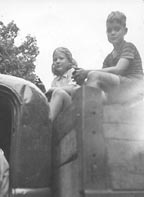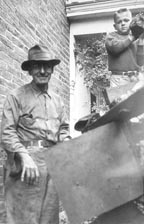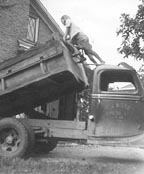Originally 421 Oak Street was heated with individual stoves in each room. One can only wonder how they worked. To this day, if you look closely, you can see the plastered over holes where the smokestacks went through the walls. Furnaces
There was a large monster that sat smack dab in the middle of the cellar. Well, actually the cellar was partitioned off into two rooms. The first room at the bottom of the cellar steps was set up with a workbench area, canning shelves, and the washing machine. The walls were made of limestone.
The second (south) room was where the furnace stood. Large sheet metal ductwork pulled the cold air in from the grates in the dining room and the hallway, and then returned the warmed air to the first floor through various registers which were located in the floors. There was no fan for this operation as it depended on the cold air dropping and the warmed air rising. One register was ingeniously placed along the wall in the living room at the chimney. (That was a great place to lay in front of and warm the feet.)

The large lumps of coal were slid down a chute from Nixon's coal truck, through the basement window at the front of the house, and landed in the coal bin. The actual shoveling of coal into the furnace was before my memory. I remember the large tongs and hooks that were used to place the coal in the proper position and the shoveling of the hot ashes out to be placed in a corner of the cellar prior to the periodic removal to the lower lot.
Well, that setup worked for a few years and then Dad made up his mind to modernize. One summer the old monster was removed and concrete was poured to replace the dirt floor. Proper pitch was considered in the design and an open pit was left in a lower area to allow for drainage.
Then the new modern stoker furnace was put in place. It featured a screw fed hopper that brought the smaller ground coal over from the coal bin and into the firebox. The shovel was now only needed to keep the auger in the bin covered with coal. The resulting combustion was much improved, with air being injected into the process. The ash formed circular clinkers that were broken apart and removed to the ash heap in the corner. The heat transfer was completed with a blower system.Bob Wells watching local concrete workers prepare to put cement floor in basement at 421 Oak. Now the house was warmer with less labor. Still the upstairs bedrooms required an iron constitution in the winter months. The only heat available there came through passive registers in the floor that passed warmth up from below.
Sometime after I left the house in the 50's, one more heating advance was made. The coal era was passing and a natural gas line brought into town. The new gas furnace seems so out of place in that old basement. It hardly takes up any room, but it does allow for additional storage space. If you look closely at the walls at the south end of the celler, you will still find traces of coal dust as a mute testimony to a bygone era.


